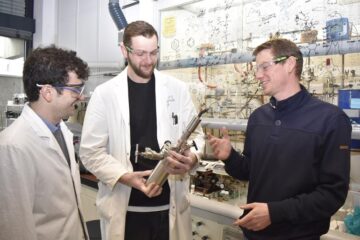La Nina Drives Down March 2011 Temperatures

Global climate trend since Nov. 16, 1978: +0.14 C per decade
March temperatures (preliminary)
Global composite temp.: -0.10 C (about 0.18 degrees Fahrenheit) below 30-year average for March.
Northern Hemisphere: -0.07 C (about 0.13 degrees Fahrenheit) below 30 year average for March.
Southern Hemisphere: -0.13 C (about 0.23 degrees Fahrenheit) above/below 30-year average for March.
Tropics: -0.35 C (about 0.63 degrees Fahrenheit) below 30-year average for March.
February temperatures (revised):
Global Composite: -0.02 C below 30-year average
Northern Hemisphere: -0.04 C below 30-year average
Southern Hemisphere: ±0.00 C above/below 30-year average
Tropics: -0.35 C below 30-year average
(All temperature anomalies are based on a 30-year average (1981-2010) for the month reported.)
Notes on data released April 5, 2011:
Driven by the La Nina Pacific Ocean cooling event, global average temperatures in March 2011 were the coolest March since 1999, according to Dr. John Christy, professor of atmospheric science and director of the Earth System Science Center at The University of Alabama in Huntsville.
It was the fifth coolest March in the tropics, where the average temperature fell 0.35 C (about 0.63 degrees Fahrenheit) below seasonal norms. Three of the five coldest tropical Marches in the 33-year satellite temperature record have happened in the past dozen years: 5th, 2011, -0.35 C: 3rd, 2000, -0.42; and 2nd, 2008, -0.58 C.
Coldest Marches In the 33-yr Satellite Record
(Degrees Celsius)
GLOBAL AVERAGE
1. 1993 3 -0.45
2. 1982 3 -0.35
3. 1989 3 -0.3
4. 1986 3 -0.26
5. 1979 3 -0.25
6. 1984 3 -0.23
7. 1985 3 -0.23
8. 1994 3 -0.23
9. 1987 3 -0.18
10. 1997 3 -0.13
11. 1995 3 -0.12
12. 1992 3 -0.11
13. 1980 3 -0.1
14. 1999 3 -0.1
15.*2011 3 -0.1
NO. HEMISPHERE
1. 1982 3 -0.57
2. 1984 3 -0.53
3. 1985 3 -0.5
4. 1993 3 -0.47
5. 1980 3 -0.4
6. 1986 3 -0.36
7. 1979 3 -0.33
8. 1989 3 -0.29
9. 1992 3 -0.22
10. 1994 3 -0.21
11. 1987 3 -0.21
12. 1995 3 -0.16
13. 1997 3 -0.14
14. 1996 3 -0.14
15.*2011 3 -0.07
SO. HEMISPHERE
1. 1993 3 -0.43
2. 2008 3 -0.37
3. 1989 3 -0.32
4. 1994 3 -0.26
5. 1979 3 -0.17
6. 1987 3 -0.16
7. 1999 3 -0.16
8. 1986 3 -0.15
9. 1990 3 -0.14
10. 1982 3 -0.13
10.*2011 3 -0.13
11. 1997 3 -0.12
12. 2001 3 -0.09
13. 1995 3 -0.08
14. 2000 3 -0.07
15. 1992 3 -0.01
TROPICS
1. 1989 3 -0.75
2. 2008 3 -0.58
3. 2000 3 -0.42
4. 1993 3 -0.36
5.*2011 3 -0.35
6. 1986 3 -0.34
7. 1997 3 -0.28
8. 1999 3 -0.25
9. 2001 3 -0.24
10. 1985 3 -0.23
11. 1990 3 -0.18
12. 1994 3 -0.16
13. 2009 3 -0.16
14. 1984 3 -0.12
15. 1979 3 -0.1
As part of an ongoing joint project between UAHuntsville, NOAA and NASA, Christy and Dr. Roy Spencer, a principal research scientist in the ESSC, use data gathered by advanced microwave sounding units on NOAA and NASA satellites to get accurate temperature readings for almost all regions of the Earth. This includes remote desert, ocean and rain forest areas where reliable climate data are not otherwise available.
The satellite-based instruments measure the temperature of the atmosphere from the surface up to an altitude of about eight kilometers above sea level. Once the monthly temperature data is collected and processed, it is placed in a “public” computer file for immediate access by atmospheric scientists in the U.S. and abroad.
Neither Christy nor Spencer receives any research support or funding from oil, coal or industrial companies or organizations, or from any private or special interest groups. All of their climate research funding comes from federal and state grants or contracts.
Dr. John Christy, (256) 961-7763
john.christy@nsstc.uah.edu
Dr. Roy Spencer, (256) 961-7960
roy.spencer@nsstc.uah.edu
Media Contact
More Information:
http://www.uah.eduAll latest news from the category: Earth Sciences
Earth Sciences (also referred to as Geosciences), which deals with basic issues surrounding our planet, plays a vital role in the area of energy and raw materials supply.
Earth Sciences comprises subjects such as geology, geography, geological informatics, paleontology, mineralogy, petrography, crystallography, geophysics, geodesy, glaciology, cartography, photogrammetry, meteorology and seismology, early-warning systems, earthquake research and polar research.
Newest articles

Lower dose of mpox vaccine is safe
… and generates six-week antibody response equivalent to standard regimen. Study highlights need for defined markers of mpox immunity to inform public health use. A dose-sparing intradermal mpox vaccination regimen…

Efficient, sustainable and cost-effective hybrid energy storage system for modern power grids
EU project HyFlow: Over three years of research, the consortium of the EU project HyFlow has successfully developed a highly efficient, sustainable, and cost-effective hybrid energy storage system (HESS) that…

Safer alternative for an explosive reaction
The chemical industry has been using a reaction with explosive chemicals for over 100 years – now Mülheim scientists have discovered a safer alternative. The Ritter Group of the Max…





















